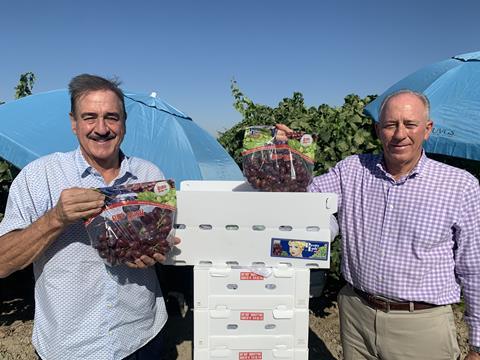Poor weather and declining acreage saw volumes dip in recent years, but investments in high yielding varieties have California’s volumes rising again
The 2025 California San Joaquin Valley table grape season got underway the last week of June, slightly early by historical standards.

“We’ve had great growing conditions leading up to the harvest,” noted John Harley of Anthony Vineyards in early July. “This could be one of the best years for fruit quality we’ve seen in some time.”
Nick Dulcich of Pretty Lady Vineyards agrees.
“So far, the weather (in the San Joaquin Valley) has been nearly perfect,” he said. “It’s very different from last year because that huge heat wave hit just as picking started, which hurt the fruit for most of the season. This year, the early varieties are starting off strong and sweet with very little decay apparent.”
With costs of production continuing to rise to unprecedented levels and US per capita consumption flagging, the San Joaquin industry has been transitioning to varieties that are high-yielding and robust in flavour.
Acreage for Sugraone, the traditional first-of-the-season green variety, has been declining for years, replaced by Ivory and other upstart varietals such as Sugar Drop. And while Flame Seedless continues to be the primary early red, Sun World bred Ruby Rush – a larger, sweeter and heavy yielder – has been catching grower attention as a potential replacement. As for black grapes, demand remains in decline.
“There are fewer black grapes (planted) every year, as consumers follow the flavour, especially for greens,” noted Harley.
As of the beginning of July, the California Table Grape Commission had yet to announce an official 2025 volume forecast, saying only that it expected production to exceed last year’s 91.5mn cartons. Industry speculation pegs the crop at around 98mn cartons, which would be the largest volume so far this decade if correct. With the exception of the tropical storm impacted season of 2023, the industry has averaged 94.5mn shipped cartons since 2021 as growers have steadily removed marginal acreage. Not that many years ago, the state’s production regularly topped 110mn cartons, with oversupply and poor markets a frequent result.
“California seems to have found a new ‘comfort level’ at around the 90-95mn carton range (per season),” says Harley. “Even though there’s less acreage, the higher yields of these new varietals have brought things more into balance for our industry.”
For the full version of this article and more coverage on the US table grape industry, subscribe to Asiafruit Magazine



